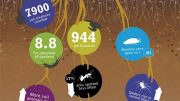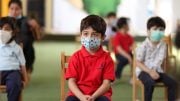
Tracking lead levels in soil over time is critical for cities to determine lead contamination risks for their youngest and most vulnerable residents, according to a new Tulane University study published in the Proceedings of the National Academy of Sciences.
The study, which focuses on New Orleans but may be applied to cities throughout the world, is the first to demonstrate how long-term changes in soil lead levels affect children’s blood lead levels.
“Lead dust is invisible and it’s tragic that lead-contaminated outdoor areas are unwittingly provided for children as places to play,” says lead study author Howard Mielke, a pharmacology research professor at Tulane University School of Medicine. “Young children are extremely vulnerable to lead poisoning because of their normal crawling, hand-to-mouth, exploratory behavior.”
Lead poisoning is frequently permanent, especially in children, and symptoms include behavioral or learning issues, lower IQ, hyperactivity, delayed development, hearing problems, anemia, renal illness, and cancer. Exposure can cause seizures, comas, or death in rare situations.
Children in metropolitan New Orleans with greater lead in the soil and higher blood lead levels had the lowest school performance ratings. Lead was recently identified as a leading cause of early death in the United States, primarily from cardiovascular disease, accounting for 412,000 fatalities per year.

Lead study author Howard Mielke is a professor of pharmacology at Tulane University School of Medicine. Credit: Paula Burch-Celentano, Tulane University
The research team began tracking the amount of lead in New Orleans soil in 2001, collecting about 5,500 samples in neighborhoods, along busy streets, close to houses, and in open spaces including parks. The team from Mielke’s Lead Lab collected another round of soil sampling 16 years later. Those samples showed a 44% decrease in the amount of soil lead in communities flooded during Hurricane Katrina in 2005 as well as soils in communities not affected by the levee failures and storm surge.
Researchers then compared the soil lead with children’s blood lead data maintained by the Louisiana Healthy Homes and Childhood Lead Poisoning Prevention Program from 2000-2005 and 2011-2016. Researchers found that lead in blood samples decreased by 64% from 2000-2005 to the 2011-2016 time period and that decreasing lead in topsoil played a key factor in the declining children’s blood lead levels.
Lead exposure is a critical environmental justice issue, according to researchers. The team found black children were three times more likely than white children to have higher blood lead levels, which could be explained by socioeconomic status and education, the type and age of housing and proximity to major roads and industry.
“While the metabolism of the city could theoretically affect all residents equally, in reality, social formations produce inequitable outcomes in which vulnerable populations tend to bear greater burdens of contaminant exposure,” Mielke says.
Mielke says further study is needed to determine if demographic changes in New Orleans since 2001 contributed to the decline in children’s blood lead levels, and if decreases are occurring equitably for all populations.
The study is co-authored by researchers from Australia, Colorado State University, and the City University of New York.
Reference: “The concurrent decline of soil lead and children’s blood lead in New Orleans” by Howard W. Mielke, Christopher R. Gonzales, Eric T. Powell, Mark A. S. Laidlaw, Kenneth J. Berry, Paul W. Mielke Jr. and Sara Perl Egendorf, 14 October 2019, Proceedings of the National Academy of Sciences.
DOI: 10.1073/pnas.1906092116









Be the first to comment on "Tracking Topsoil Lead Levels Is Critical for Assessing Lead Exposure Risks for Children"